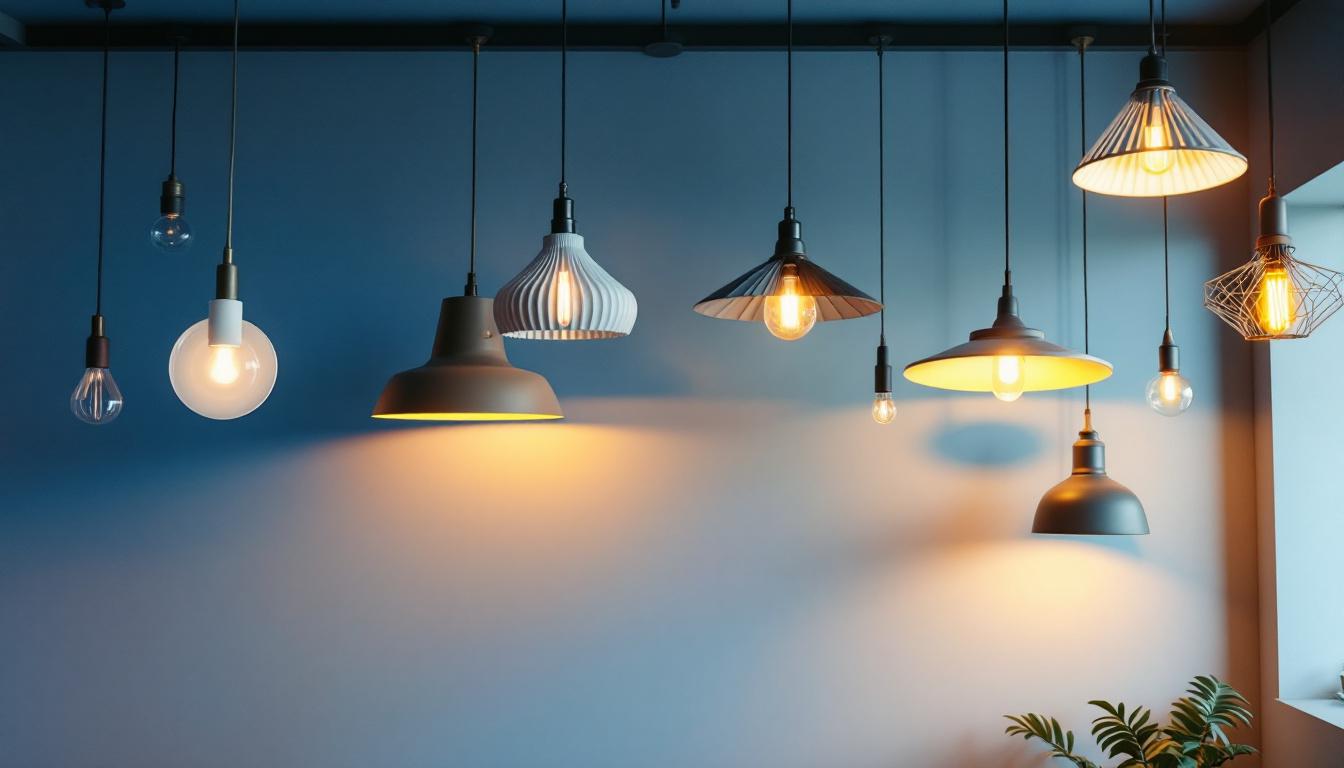
In the ever-evolving world of interior design, hanging ceiling lights have emerged as a staple in modern spaces. For lighting contractors, understanding the nuances of these fixtures is essential for delivering exceptional results to clients. This article delves into proven methods for selecting, installing, and maintaining modern hanging ceiling lights, ensuring that contractors can provide both aesthetic appeal and functional lighting solutions.
Modern hanging ceiling lights encompass a variety of styles, designs, and functionalities. From sleek pendant lights to intricate chandeliers, these fixtures can dramatically alter the ambiance of a room. Recognizing the different types available is crucial for contractors aiming to meet diverse client needs.
The market offers a plethora of hanging ceiling light options, each with unique characteristics. Pendant lights, for instance, are versatile and can be used in various settings, from kitchens to dining areas. They come in different shapes and sizes, making them suitable for both minimalist and elaborate designs.
Chandeliers, on the other hand, are often associated with luxury and elegance. They can serve as a focal point in larger rooms, providing both illumination and artistic flair. Additionally, there are multi-light fixtures that combine several bulbs into one cohesive design, allowing for greater light distribution. These multi-light designs can create a stunning visual impact, especially in open-concept spaces where they can be admired from multiple angles.
When selecting hanging ceiling lights, design considerations play a pivotal role. Contractors should assess the overall style of the space, including color schemes, furniture, and architectural elements. A modern space may benefit from sleek, geometric designs, while a more traditional setting could call for ornate fixtures.
Scale is another important factor. The size of the hanging light should be proportionate to the room. A large chandelier can overwhelm a small dining area, while a tiny pendant may get lost in a spacious foyer. Ensuring the right scale enhances both functionality and aesthetic appeal. Furthermore, the height at which these fixtures are hung is critical; too low can obstruct views and movement, while too high may diminish their visual impact. A general guideline is to hang pendants about 30 to 36 inches above a dining table, ensuring they illuminate the space without obstructing conversation.
Moreover, the choice of materials and finishes can significantly influence the overall look of the lighting fixture. Metal finishes like brass or matte black can lend a contemporary edge, while glass or crystal elements can add a touch of sophistication. It’s essential to consider how these materials will interact with the existing decor and lighting in the room. For instance, a brushed nickel pendant can complement stainless steel appliances in a modern kitchen, while a vintage-style chandelier might enhance the charm of a rustic dining room.
Proper installation is key to ensuring that hanging ceiling lights function as intended and contribute positively to the overall design. Contractors must adhere to best practices to achieve optimal results.
Before installation, thorough planning is essential. Contractors should assess the existing electrical infrastructure and ensure it can support the new fixtures. This includes checking for adequate wiring, circuit capacity, and the location of switches. Proper planning can prevent costly adjustments later on.
Additionally, measuring the height at which the lights will hang is crucial. A general rule of thumb is to hang pendant lights approximately 30 to 36 inches above a dining table. For chandeliers, the height should be adjusted based on ceiling height and the size of the fixture. This attention to detail ensures that the lighting is both functional and visually pleasing. Furthermore, considering the overall design theme of the space can enhance the aesthetic appeal. For instance, a rustic chandelier may complement a farmhouse-style kitchen, while sleek, modern pendants can elevate a contemporary dining area.
The installation process typically involves several key steps. First, ensure the power is turned off at the circuit breaker to avoid any electrical hazards. Next, remove the existing fixture if applicable, and prepare the mounting bracket for the new light. It’s important to securely attach the bracket to the ceiling to support the weight of the hanging light.
Once the bracket is in place, connect the wiring according to the manufacturer’s instructions. This often involves matching wire colors and securing them with wire nuts. After connecting the wires, carefully attach the light fixture to the bracket and ensure it is level. Finally, restore power and test the light to confirm proper functionality. Additionally, it’s wise to consider the type of bulbs being used, as different bulbs can significantly affect the ambiance of the room. LED bulbs, for example, offer energy efficiency and longevity, while incandescent bulbs provide a warm, inviting glow. Choosing the right bulb can enhance the overall effect of the lighting, making it not just a functional element, but a key component of the room’s atmosphere.
The choice of bulbs can significantly impact the performance and ambiance of hanging ceiling lights. As energy efficiency and sustainability become increasingly important, contractors must stay informed about the latest advancements in lighting technology. The right bulb not only enhances the aesthetic appeal of a space but also contributes to energy savings and reduced environmental impact, making it essential for contractors to consider both functionality and style when selecting lighting solutions.
LED bulbs are a popular choice due to their energy efficiency and long lifespan. They produce less heat compared to traditional incandescent bulbs, making them a safer option for hanging fixtures. Additionally, LED bulbs are available in various color temperatures, allowing contractors to create the desired mood in a space. Furthermore, advancements in LED technology have led to the development of smart bulbs that can be controlled via smartphone apps, enabling users to adjust brightness and color temperature on demand, thereby enhancing the versatility of lighting designs.
Compact fluorescent lamps (CFLs) are another energy-efficient option, though they may not be as widely used in hanging fixtures due to their bulkier design. These bulbs contain a small amount of mercury, which necessitates careful disposal, but they can last significantly longer than traditional incandescent bulbs. Halogen bulbs, while providing excellent brightness, are less energy-efficient and generate more heat, which can be a consideration in certain installations. They are often favored for their crisp, white light and ability to render colors accurately, making them suitable for art galleries and retail environments where lighting quality is paramount.
Understanding color temperature is vital for achieving the desired atmosphere. Measured in Kelvin (K), color temperature can range from warm (around 2700K) to cool (above 5000K). Warm light is often preferred in residential settings for its cozy feel, while cooler light may be suitable for workspaces or modern designs. The choice of color temperature can also influence mood and productivity; for instance, studies have shown that cooler light can enhance alertness and concentration, making it ideal for offices and study areas.
Brightness, measured in lumens, is also an important factor. Contractors should consider the purpose of the space when selecting bulb brightness. For example, a dining area may require softer lighting for ambiance, while a kitchen might benefit from brighter, more focused illumination. Additionally, the layout and color scheme of the room can affect how light is perceived; lighter walls can reflect more light, potentially allowing for lower lumen outputs without sacrificing visibility. It’s crucial for contractors to assess the specific needs of each space to ensure that the lighting not only meets functional requirements but also enhances the overall design aesthetic.
Regular maintenance of hanging ceiling lights is essential for ensuring their longevity and performance. Contractors should educate clients on proper care and troubleshooting techniques to address common issues.
Dust and grime can accumulate on light fixtures, diminishing their brightness and aesthetic appeal. Regular cleaning is recommended, using a soft cloth and mild soap solution to avoid damaging the finish. For intricate designs, a soft brush can help reach crevices where dust may settle.
In addition to cleaning, contractors should advise clients to periodically check the bulbs and wiring. Replacing burnt-out bulbs promptly and ensuring connections remain secure can prevent further issues and maintain optimal lighting conditions.
Despite careful installation and maintenance, issues may still arise. Flickering lights can indicate a loose connection, while dim lights may suggest a need for bulb replacement or an issue with the electrical supply. Contractors should be prepared to troubleshoot these common problems, ensuring clients receive prompt solutions.
In cases where the fixture does not turn on at all, checking the circuit breaker and ensuring the power supply is functioning is crucial. If problems persist, it may be necessary to consult an electrician for further diagnosis.
The lighting industry is constantly evolving, with new trends emerging regularly. Staying informed about these innovations can help contractors offer cutting-edge solutions to clients.
Smart lighting technology has gained popularity in recent years, allowing users to control their lighting remotely through mobile devices or smart home systems. This technology offers convenience and the ability to customize lighting settings based on personal preferences.
For contractors, integrating smart lighting into hanging fixtures can enhance the overall appeal of a project. Clients may appreciate the ability to adjust brightness, color temperature, and even set schedules for their lights, all from the convenience of their smartphones.
As sustainability becomes a priority for many homeowners, eco-friendly lighting options are increasingly in demand. This includes energy-efficient bulbs, fixtures made from sustainable materials, and designs that minimize energy consumption.
Contractors can differentiate themselves by offering eco-friendly solutions that align with clients’ values. This not only enhances the project’s appeal but also contributes positively to the environment.
Modern hanging ceiling lights are more than mere fixtures; they are essential elements of interior design that can transform a space. For lighting contractors, mastering the art of selecting, installing, and maintaining these lights is crucial for delivering exceptional service. By understanding the various types of hanging lights, employing effective installation techniques, choosing the right bulbs, and staying abreast of innovative trends, contractors can ensure their projects shine brightly.
As the lighting landscape continues to evolve, embracing new technologies and sustainable practices will position contractors as leaders in the industry. Ultimately, the goal is to create beautifully lit spaces that enhance both functionality and aesthetics, leaving a lasting impression on clients.
Ready to elevate your lighting projects with the latest in modern hanging ceiling lights? Look no further than LumenWholesale, where we provide lighting contractors with the highest quality, spec-grade lighting products at unbeatable wholesale prices. Say goodbye to local distributor markups and hello to a vast selection of reliable, high-performance lighting that meets the strictest industry standards. With free shipping on bulk orders, LumenWholesale is your go-to source for premium lighting solutions that blend quality, affordability, and convenience seamlessly. Don’t compromise on your lighting needs—choose Wholesale Lighting at the Best Value and make a lasting impression on your clients with LumenWholesale.

Discover the key differences between T5 and T8 lighting systems and how choosing the right one can enhance efficiency and profitability for lighting contractors.

Explore the essential insights every lighting contractor needs to know about fluorescent lights, from energy efficiency to installation tips, in this comprehensive guide.

Discover the transformative advantages of smart switches for lighting contractors.

Discover the pivotal role exterior work lights play for lighting contractors in enhancing safety, efficiency, and project quality.